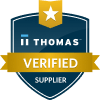Impact of Material Selection On The Cost of Metal Stamped Parts
Leave a CommentWhen sheet metal formed parts are needed in high volume, metal stamping becomes the most viable option for a production process. This acceleration in part count means an even greater focus on per part cost and Total Cost of Ownership (TCO). While many aspects of the part design and metal stamping production process factor into the overall cost, material selection is an area that a business can control and plan to ensure the best possible long term per part price for their metal stamped parts.
Material Wear on Die
Every strike of the press causes wear on the die or dies involved in the metal stamping process. The material used to make the end components affects the timeline for die tooling surface wear due to the friction produced in the forming process. The most common materials used in metal stamped parts are steel, stainless steel, copper, brass, nickel and aluminum. Softer and more malleable material like copper will cause less wear on the die, while harder and stronger materials like titanium are more difficult to stamp and cause more wear on the tooling in a shorter period of time. There are different tool steel and die coating options that exist that can slow die wear when stronger materials are required, but that increases the overall cost of the parts being produced.
Material Properties, Thickness, and Part Quality Concerns
The composition and physical properties of the material selected to produce your metal stamped components play a part in determining the difficulty of achieving highly repeatable quality control standards. While harder and stronger materials add wear to the die, they take well to the metal stamping forming process through a wide range of material thickness producing less QC issues. Softer more flexible and malleable materials perform well at greater thickness, but can shear or fail more easily while forming certain features of the component. Thin walled components made from softer materials will tend to have more challenging QC processes required, driving up the cost of your metal stamped parts. Work with the Design For Manufacturability (DFM) team closely when working with very thin materials. They can help you identify alternatives or die design approaches to overcome the difficulties this requirement produces.
Material Sheet Size and Coil Width
Your metal stamping supplier can help select the appropriate sheet metal size or coil width to best produce your part. The geometry and features of your part will dictate the amount of material necessary to produce the end result, but your supplier can design the best orientation for the metal stamping process to save you the most money. The percentage of scrap produced per run creates additional cost per part with no benefit. Reducing scrap saves you money and does not affect the performance of your parts. This is a good way to keep your overall costs down.
Material Cost and Availability
As we saw through 2020 and 2021 material cost and availability can be impacted by much more than the standard supply volume being outrun by a sharp increase in demand. Tariffs, shipping challenges, scarcity of 3PL services, mill closures, geopolitical discourse, and global pandemics can all affect the cost of your material pricing and in turn your per part price. Widely used materials like 6061 Aluminum are the most likely to be available at the best price during the most difficult of times and challenging situations. Materials with other valuable properties like high conductivity can be harder to get due to the multi-use end case for the raw material. Titanium and other exotic metals will always be on the more expensive end of the material cost spectrum and have a high likelihood to be harder to find when external factors impact your supply chain.
Be sure to understand all of your material options when moving your parts to a high volume metal stamping process – it is a big part of the answer to the question “How Much Does Metal Stamping Cost?”. What may have worked well at low volume should be reassessed, evaluated, and either confirmed to have the same material requirements or an alternative can be identified to save you money.



